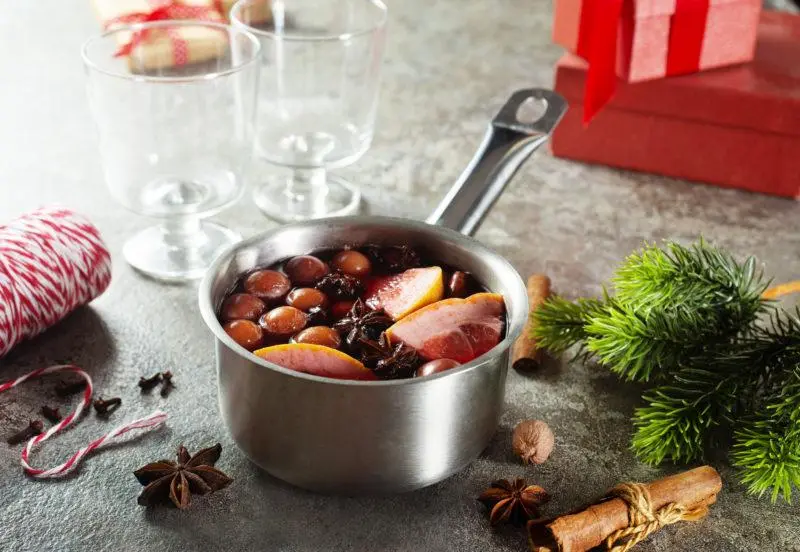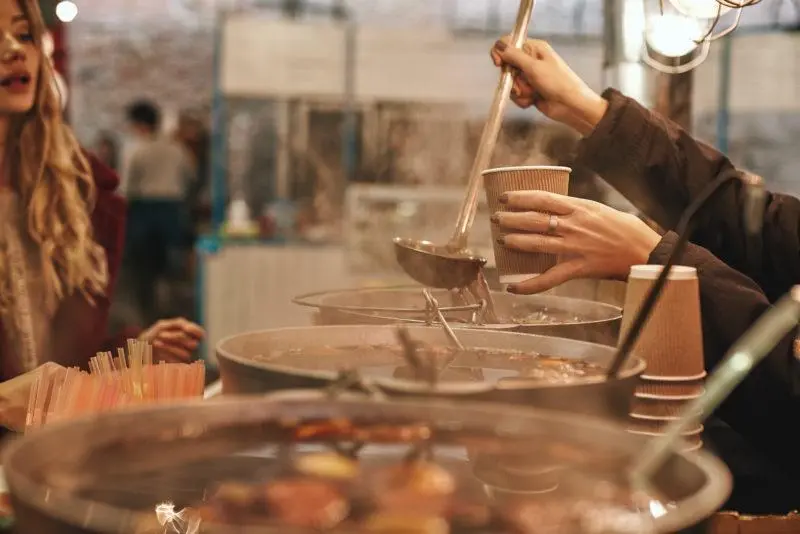Contents
The sweet and sour compote that is poured at the fairs during the Christmas season is a sad event for a drink originally created to showcase the wealth and generosity of a medieval home. Mulled wine is not just an excuse to serve ridiculously cheap wine to guests, although that has the added benefit of warmed alcohol, but a real art. The art of honoring traditions, maintaining balance and applying modern cooking methods!
To understand which of the mulled wines can be considered classic, we will rely on widely known information about the origin of this drink. It was first brewed in ancient Rome. In any case, it was with the Roman legions around the 2nd century that spiced and heated wine began its long journey through Europe. The Romans were especially zealous in warming wine in the northern countries, and everything indicates that mulled wine settled in Britain, which was dank to the bone, earlier than among other northerners.
As far back as medieval England, a drink was prepared that closely resembles most of today’s hot wines, namely Pur fait Ypocras, the recipe for which was first discovered in the 1390 cookbook The Forme of Cury. Hypocras is a spicy wine, heavily flavored with honey, which is usually isolated as a separate type of aperitif and is still made in the French regions of Ariège and Haute-Loire.

The recipe from The Forme of Cury reads: “… grind together cinnamon, ginger, galangal root, cloves, long pepper, nutmeg, marjoram, cardamom, and Meleget pepper (also known as ‘seeds of paradise’; rosemary may be a valid substitute) . Mix all this with red wine and sugar (form and quantity not specified). It’s a very spicy drink, tasting more like something you could use to ward off the plague rather than to party on cold, candle-lit evenings in the 14th century.
After Pur fait Ypocras, there was no major development in the evolution of mulled wine for a long time, until Isabella Mary Beaton, known to us earlier from a reliable recipe for Scottish ginger wine, took it up. In her 1861 Mrs Beeton’s Book of Housekeeping, she gives a simple but rather vague recipe for mulled wine. But instead of just sticking all the ingredients in a pot and hoping for the best, the Victorian journalist suggests first brewing a fragrant “tea” with spices and a little water.
For me it was a discovery – the drink turns out to be more whole and complex. Subsequently, a recipe was formed, which I dubbed the British classic. Indeed, a time-tested, not outstanding, but reliable classic!
Important! Under no circumstances bring the wine to a boil! When boiling, the drink quickly loses alcohol, and it can acquire a compote taste (and excessive acidity), which is not at all typical for it. The optimum temperature for mulled wine is 70-78 оC, just when a white foam appears on the surface. But at this temperature, it is impossible to fully extract aromatic substances from spices, so the preparation of “tea” from spices is an important, logically justified procedure.
Classic British mulled wine
Traditional English mulled wine with a modern twist and a wide variety of ingredients.
A type warming drink
Kitchen english
Prepare 10 minutes
Cooking 30 minutes
Total 30 minutes
Portions 12 portions
Ingredients
- 2 large oranges
- 1 lemon
- 150 г sahara (or powdered sugar)
- 1-3 cinnamon sticks
- 5-10 carnation buds
- a pinch of fresh nutmeg
- other spices (taste)
- 200 ml water (Optional)
- 2 bottles dry red wine (1,5 l)
- 100-250 ml strong alcohol
Instructions
Pour oranges and lemon over with boiling water and rub thoroughly with a hard towel to remove the wax. Then, with a vegetable peeling knife, remove the zest from them, avoiding the white skin.
Place the zest in a heavy-bottomed saucepan, add spices and water. Part of the water can be replaced with juice from one orange, no more. Bring to a boil and simmer, stirring occasionally, for 10-15 minutes.

Reduce heat and add sugar. Stir until completely dissolved.
Add strong alcohol, simmer with syrup over low heat for 5 minutes and add dry wine.
Bring mulled wine to a temperature of 70-80 degrees (at this temperature, white foam begins to appear), stirring occasionally, cover with a lid and turn off the heat.
Let the drink brew for 40-60 minutes (optional, but highly desirable), then warm up and serve. The spices left in the pot can be reused.

Field notes
Wine. Choose full-bodied, full-bodied red dry or semi-sweet wines such as Cabernet, Claret, Bordeaux, Zinfandel, Chianti or, say, Kindzmarauli. You can use white wine, but this is already an amateur. Fortified specimens do not agree well with mulled wine, which overload the drink with heavy alcoholic tones – it is better to add a little port or Madeira to the already prepared mulled wine to add a little strength and complexity to it.
Do not use wine that you would not drink just like that, but it does not make sense to spend money on expensive ones. We’ll have to find a compromise. The Germans, for example, found it not in the search for an ideal price-quality ratio, but in the use of homemade fruit wines, in particular cherry and blackberry (see the links for recipes for these wines). It is not uncommon for the British to use cider or even some local ale as a base, but that is another story.
Специи. The traditional spices for mulled wine, which have always been in it, include cloves, cinnamon and nutmeg. I also add a few black peppercorns and 1-2 star anise. Feel free to add your favorite spices to the drink, for example: fresh ginger root, bay leaf, allspice, white and pink pepper, cardamom, vanilla, fennel, anise, etc. You can add some herbs, for example, a couple of sprigs of rosemary, mint or sage. But do not overdo it – spicy soup is not about mulled wine. I always use spices whole, lightly beaten in a mortar, and I advise you to do the same.
Fruit. The zest of oranges (or clementines) is classic here. You can add the zest of other citrus fruits, in particular lemon or lime. In my first mulled wines, I added whole fruits, in slices, but then the drink acquires a compote taste and becomes a little sourer than it should be. If this does not scare you (after all, excess acidity can be easily balanced with a sweetener), you can add slices of any available fruits and / or berries to your warming drink: apples, pears, cranberries, raspberries, blackberries, etc.
Sweetener. White sugar, or even better powdered sugar for quick dissolution, will be the most neutral source of sweetness. Brown cane sugar will add a little warmth and make it more expressive, but this is not for everyone. Honey has always been a good alternative to sugar, but not every stomach can withstand it in a heated form (I will not mention the dangers of honey heated above 40 degrees; although I did mention it).
Strong alcohol. Most traditional mulled wine recipes (in an international context) include fruit brandy or rum as an additional alcohol. No less common are various fortified wines, such as port, Madeira and sherry. In England, the fortified ginger wine mentioned above is often used, which is supposed to be prepared at home. The range of spirits in mulled wines can be expanded endlessly: vodka, aquavit, calvados, whiskey, dry liqueurs like Cointreau, savory liqueurs like Amaretto, sweet liqueurs like Limoncello, drinking bitters like Campari, etc. etc.
If you want mulled wine to look fancy, garnish it with a slice of orange stuffed with cinnamon, a classic decoration used throughout Europe.
Our friends from Dobrovar filmed a video recipe for a classic British mulled wine using the above, for which many thanks to them:
Jamie Oliver’s Flawless Mulled Wine
Since I discovered Mrs Beaton’s perfect hot wine, an important event has taken place in the world of mulled wine – the British culinary specialist and great prankster Jamie Oliver had a hand in modernizing it. Instead of a one-step process and pre-boiling the spices in water, he suggested making a concentrated wine syrup first. There is a controversial point with the addition of citrus juice to the drink (again, acidity increases), but in general, I consider this method the most successful. In addition, the idea arose to prepare such a syrup with a margin and use it as needed throughout the mulled wine season. What do you think?

- 2 clementines or small oranges
- 1 medium lemon
- 1 medium lime
- 200 grams of powdered sugar
- 6 clove buds
- 1 cinnamon stick
- 3 bay leaves
- 1 whole nutmeg
- 1 vanilla pod
- 2 star anise
- 2 bottles of red wine
Jamie Oliver Technology:
With a paring knife, remove the zest from citrus fruits, trying to cling as little as possible to the bitter albedo, white subcutaneous. Pour sugar into a large saucepan, add citrus zest and squeezed juice from clementines (or oranges, this is not necessary). Add cloves, cinnamon, bay leaf and about 10-12 slices of nutmeg on the finest grater. Cut the vanilla pod lengthwise, scrape the seeds into a saucepan and toss the rest of the pod into the same place. Then add enough red wine to completely cover the sugar and spices.

Place the saucepan over medium heat and bring the mixture to a boil, stirring constantly with a wooden spoon. After 4-5 minutes of boiling, you should get a beautiful, fragrant, thick syrup. Now the fire can be reduced to a minimum, add anise and the rest of the wine. After about 5 minutes, when the wine has warmed up to the desired temperature, pour the finished mulled wine into glasses and serve.
Traditional mulled wines of continental Europe
In Germany, at least since about 1420 (the first documented silver mulled wine mug belongs to Count John IV of Katzenelnbogen), Glühwein has been brewed. This is exactly the same mulled wine that the average Russian usually prepares. Red wine is heated along with cinnamon sticks, cloves, star anise, citrus fruits, sugar, and sometimes vanilla pods. We already know about the disadvantages of this method of preparation, so we will not focus on the recipe (and in terms of composition it is not much different from the British classic).
In other parts of Europe, however, wine is heated in a similar way. But now we know how to properly prepare a fragrant base, thanks to which any recipe can become outstanding.
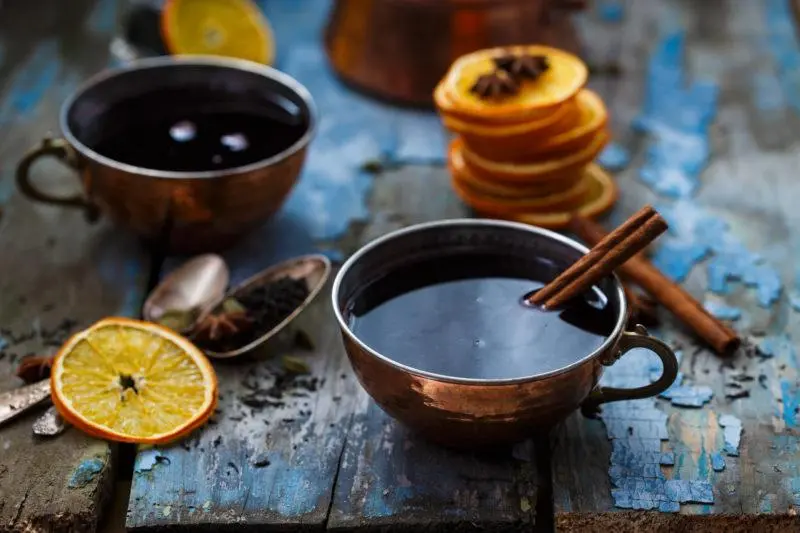
Let’s start with the Scandinavian glög, which often uses an even more interesting technique for making a spiced “tea”. In short, glögg (Swedish glögg) is a traditional mulled wine from the Nordic countries. It is usually stronger than other European counterparts and often includes dried fruits, almonds and several cardamom pods. I wrote a separate article about him, but there is always something to add. At least a little hygge on a cold winter evening in your house …

Scandinavian mulled wine “Glögg”
- 1 bottle of rich red wine
- 1 / 3 cup raisins
- 1/3 cup blanched almonds
- 5 boxes of crushed cardamom
- 5-8 cloves
- 1 cinnamon stick
- zest of a small orange
- 150-200 ml of strong alcohol*
- 75-100 g sugar or powdered sugar, to taste
* – Swedes and their sympathizers traditionally use vodka, aquavit or rum, but you can take any other alcohol with a strength of 20%+.
How to cook:
Mix wine, raisins, almonds, zest and spices in a suitable jar. Close the jar tightly and leave for 24 hours in a dark, cool place. Strain the liquid into an airtight container; save raisins for garnish. Spiced wine can be stored in the refrigerator for up to 3 months, and warmed up with sugar and strong alcohol before serving. Serve in bowls with raisins and fresh blanched almonds.
Recipe note. Some Scandinavians first prepare a spicy tincture and only then mix wine with it. To do this, spices and dried fruits (and here you can add, for example, a couple of pieces of dried figs) are poured with aquavit or cognac, all this is insisted in a dark, cool place for 3-4 days, and then the resulting infusion is mixed with wine and heated. Sometimes glög is prepared using the flambé technique, when lump sugar soaked in alcoholic fuel is set on fire over already warmed wine (it seems that the hussars went to the Swedes to burn).
Now let’s move further south to Portugal, where mulled wine is traditionally made with local fortified wines, mostly port. They call it “Vinho Quente” or “Porto Quente” and here is its typical recipe:
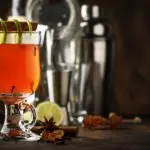
Portuguese mulled wine “Vinho Quente”
- 1 l red wine
- 150 ml of inexpensive port wine
- 50 ml of grape brandy
- 80 g brown sugar
- zest of a small orange
- 2 cinnamon sticks
- 2 star anise
- 2 button Gvozdik
- 1 bay leaf
Cooking in the Jamie Oliver technique, although at home mulled wine is prepared in the German tradition.
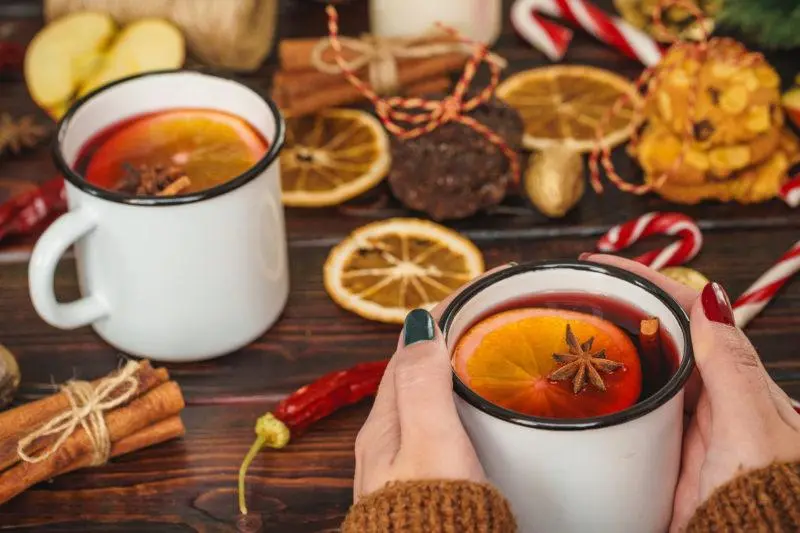
Finally, I want to share with you the recipe for the Spanish Vino Caliente. It is not quite traditional for a southern country, where the climate favors refreshing Sangria, but a kind of author’s concept that demonstrates the variety of possible ingredients for mulled wine and partly national identity. The original is made using the German Glühwein technique, but I see Jamie’s method more appropriate here. The recipe is designed for a large company, but easily scales up to standard volumes (feel free to divide by three).
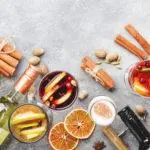
Spanish mulled wine “Vino Caliente”
- 3 bottles of rich red wine
- 1 white muscat wine bottle
- 1/3 to 2/3 bottle of sherry brandy
- splash of orange triple sec, optional
- 4-5 cinnamon sticks
- 3 large oranges, zest only
- 1 lemon, zest only
- 1-3 cm fresh ginger root, chopped
- 15 peppercorns, you can mix from different
- 15 clove buds
- 150-250 g sugar, to taste
- vanilla pod or vanilla sugar equivalent
Prepare a spiced syrup in the Jamie Oliver technique, add wine and heat until a white foam forms. Simmer on low heat for 10-20 minutes, add sherry brandy, if desired, a little orange liqueur and remove from heat. Let it brew for as long as there is enough patience, heat it up again and serve it to the table.
What is your favorite mulled wine recipe?










